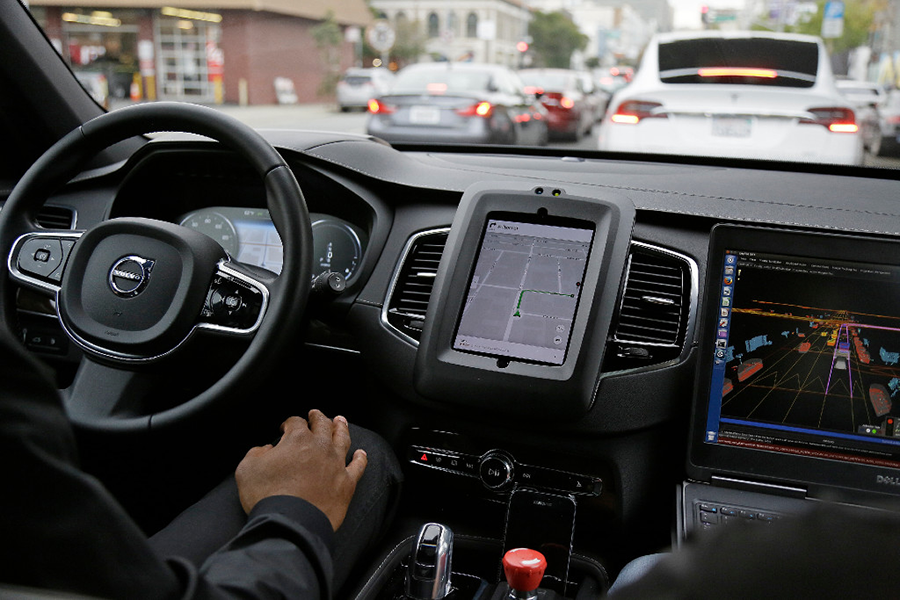Self-driving cars still seem scary to most Americans
Loading...
With so much money, technology, and competition gearing up in the budding self-driving car industry, it's easy to get the impression that autonomous vehicles are coming, and soon. But despite the advances in technology, a new survey from the American Automobile Association (AAA) seems to indicate that Americans aren’t quite ready to let the car take the wheel – at least, not yet.
The AAA survey found that 78 percent of US drivers reported feeling afraid to ride in a self-driving vehicle. Only 19 percent said they would trust the vehicle, and 4 percent said they were unsure.
Those are less-than-encouraging results for the industry, which has been growing in size in recent years. A number of companies have jumped on the self-driving bandwagon, including Google, Uber, Lyft, and several traditional automotive manufacturers.
"A great race towards autonomy is underway and companies are vying to introduce the first driverless cars to our roadways," Greg Brannon, AAA's director of Automotive Engineering and Industry Relations, said in a statement. "However, while U.S. drivers are eager to buy vehicles equipped with autonomous technology, they continue to fear a fully self-driving vehicle."
In another survey conducted by AAA in 2016, the results were almost the same – in that year, more than three-quarters of Americans also reported that they would feel unsafe in a fully self-driving car.
This continuing reluctance to embrace fully autonomous vehicles will be a significant obstacle for the industry to overcome. While many crashes today are caused by human error, most Americans feel that the technology just isn't ready to take the place of a human driver. As The Christian Science Monitor reported in February:
The National Safety Council, a nonprofit organization, said Wednesday that an estimated 40,000 Americans died from traffic accidents in 2016, a 6 percent jump from the previous year. That number, which makes 2016 the deadliest year on US roads in nearly a decade, underscores the need for rapid adoption of new automotive safety technologies, NSC said. While carmakers and industry experts hope the push for such technologies could lead to a mass adoption of autonomous cars, urban planning experts say a full embrace of the autonomous future might take longer to realize, as it faces higher hurdles in costs and policy.
Though Americans did drive more last year, as gas prices remained low, the top three causes pushing the rise in fatalities were speeding, alcohol, and distractions, according to Deborah Hersman, NSC president and chief executive officer. She adds that these safety concerns, because of drivers' bad decision-making, could be improved by newly-developed technologies, such as blind-spot monitoring and lane departure warning.
In October, together with the Department of Transportation's National Highway Traffic Safety Administration and two other agencies, the NSC announced the "Road to Zero Initiative," setting an ambitious goal of zero traffic deaths by 2046. With a $1 million grant, the NSC hopes to build a coalition that includes "develop[ing] a zero-traffic-deaths scenario through strategic deployment of self-driving cars."
But while Americans may not be ready for fully self-driving vehicles yet, a majority (59 percent) are interested in having certain autonomous features, such as emergency braking and self-parking technology in their cars, according to AAA.
"U.S. drivers may experience the driver assistance technologies in their cars today and feel they don't work consistently enough to replace a human driver – and they’re correct," said Mr. Brannon. "While these technologies will continue to improve over time, it’s important that consumers understand that today's systems require your eyes on the road and your hands on the wheel."
Much of the interest in autonomous technology for cars falls along generational lines. The survey found that 70 percent of Millennials surveyed wanted autonomous features, while only 54 percent of Gen-Xers and 51 percent of Baby Boomers were interested. Similarly, Baby Boomers were the most likely to feel afraid of riding in a self-driving vehicle (85 percent), with Generation X coming in at 75 percent and Millennials at 73. Women were also more likely to be afraid of riding in an autonomous vehicle (85 percent) compared to men (69 percent).
In order to assuage public fears, AAA stressed that the self-driving industry will need to realize the importance of a gradual transition to autonomy for vehicles in order for ordinary people to accept them in the coming years.
"Every year, we lose approximately 35,000 people on America’s roadways, most as a result of human error," said Jill Ingrassia, AAA’s managing director of Government Relations and Traffic Safety. "Connected and automated vehicle technologies have the potential to dramatically reduce this number, and automakers, government agencies and safety organizations like AAA must continue working together to ensure that these new vehicles are safely tested and deployed."








